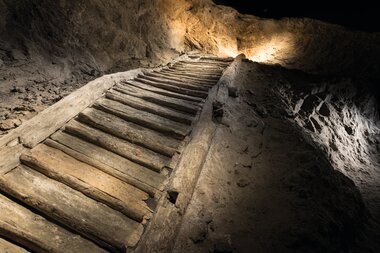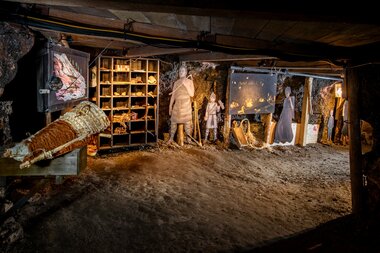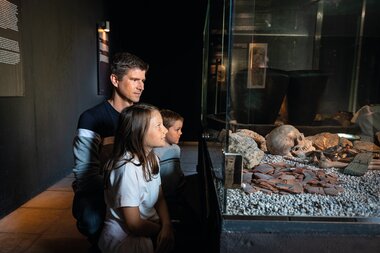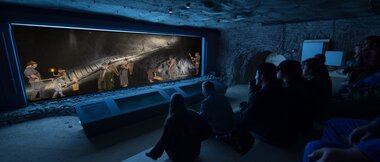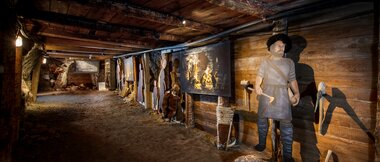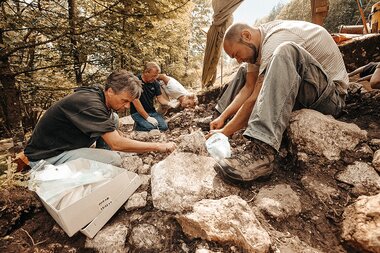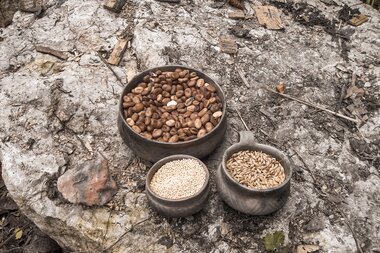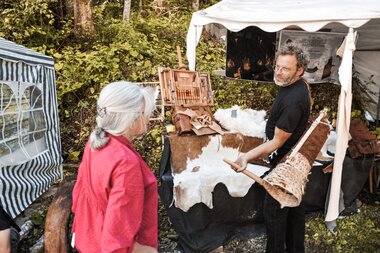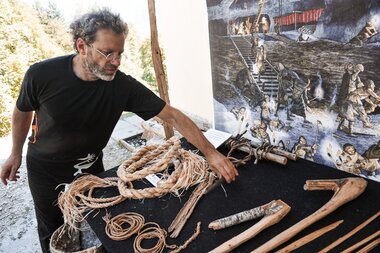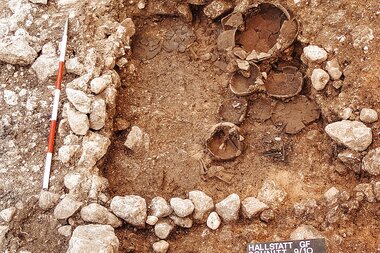Archaeology – 7,000 Years of History 7,000 years of history high above the rooftops of a UNESCO World Heritage site
As we all know, Hallstatt is a very special place: the extraordinary setting, the picturesque beauty, the mountains, the lake, its status as a UNESCO Natural & Cultural Heritage Site … But what distinguishes this corner of the world more than anything else, is the fact that people were living here 7,000 years ago. And why? Quite simply: Because there was salt here! That said, it is fair to claim that “white gold” was responsible for people settling the high valley 5,000 years BCE, for an entire age being named after this place, and today, for people coming here from around the world, submersing themselves deep within the mountain in search of ancient history spanning millennia.
The story of Hallstatt begins with a pickax made from deer antler
We find evidence of Hallstatt as a place of extraordinary historic dimension even in its name. Did you know that the term “hal(l)” actually goes all the way back to the Celts? They used the word to denote those places that were a source of salt. As was the case up in the high valley above today’s Hallstatt: There, far above the lake, people had already settled and begun mining salt by 5,000 BCE. A claim backed up by concrete archaeological evidence: In 1838, deep inside the mountain in the so-called Kaiser Josef Tunnel, an object was found made of deer antler, presumably used to dig out salt – all the way back in the Neolithic Age. Roughly 7,000 years ago! Further confirmed through radiocarbon dating of the axe conducted by Natural History Museum Vienna. However, a number of millennia would pass until more extensive salt mining began.
The oldest staircase in Europe: from the depths of the Bronze Age to the movie screen of today
Organized salt mining began in Hallstatt – in the Salzkammergut region – in the Bronze Age, between 2100 and 800 BCE. At that time, Egypt was ruled by Akhenaten and Nefertiti. In Greece, the Mycenaean Culture was at its zenith. Spectacular evidence of the organized methods employed in prehistoric mining is supplied by what appears, at first sight at least, to be a simple wooden staircase, discovered inside the Salzberg in 2002. Extensive scientific examination led to the conclusion that it was constructed roughly 1344 BCE. Meaning that the oldest staircase in Europe had been found in Hallstatt! With the scientific investigations completed, the historic exhibit was returned to the interior of the mountain. In cooperation with Natural History Museum Vienna and Salinen Austria AG, a “Bronze Age Cinema” was built inside Salzwelten Hallstatt, in the center of which stands the famous staircase. An animation projected onto the prehistoric exhibit brings the arduous working life of Bronze Age salt miners vividly to life. The benefits for staircase and visitor alike: Under the ideal conservation conditions which exist inside the mine, the prehistoric staircase and its history will remain preserved for many generations to come.
CSI Hallstatt: the “Man in Salt”
Yet another find that captured everyone’s attention was the “Man in Salt”. In the year 1734, three miners were taken aback when they discovered a male body inside Hallstatt salt mine. It turned out to be the well-preserved body of a prehistoric miner. Due to the salt, the corpse had been conserved so well that its clothing was still intact and even the skin and hair were recognizable. After thorough analysis and investigation, today’s assumption is that this man was the victim of a mining accident approximately 1000 BCE and lay hidden under debris and rubble for many centuries, until finally being discovered in the 18th century.
Tip: Join us on a prehistoric expedition!
If you are looking for a real adventure, you should sign up for a prehistoric expedition away from the regular visitors’ tour. During this tour lasting a few hours, you will feel one step closer to the miners of the far-distant past. Outfitted with protective overalls, a helmet and lamp, you will penetrate deep into the mountain and its heart of salt, to the site where the “Man in Salt” was found, along with many other treasures that generally lay hidden in the pitch darkness of the ancient tunnels
The Hallstatt Age: How one place lent its name to an entire epoch
The heyday of prehistoric mining, however, was in the late Iron Age between 800 and ca. 400 BCE. At that time, miners would penetrate as much as 200 meters into the mountain. With simple tools, they dug tunnels into the mountain, battling meter by meter through bare rock in order to expose the “white gold”. This treasure made it possible for the people to prosper and settle. Evidence of this is provided by the extraordinarily rich burial grounds, which had already been discovered in the Salzberg valley by the year 1600, and the finds inside the mine itself. Thanks to the preservative effects of salt, this represents a unique archaeological treasure trove, granting us insights into the lives of miners long, long ago. The underground discoveries include the oldest staircase in Europe along with primitive ladders, pickaxes, ropes, animal pelts, carrying sacks, cloths, remnants of clothing, shoes and food leftovers, and even what remains of the food after it has been digested. And it is precisely because of this wealth of finds that a small town in the Salzkammergut Region gave its name to an entire historical epoch: the Hallstatt Age.
Insider Tip: Peek over the archaeologists’ shoulders as they go about “bone collecting”!
Would you like to learn more about the work done by archaeologists and excavations conducted inside the Salzberg above Hallstatt?
Every year during the summer months, scientists from Natural History Museum Vienna come to the Hallstatt high valley. That’s when you can watch them go about their work – and perhaps even be there live when a find from the past first sees the light of the present day.
Incidentally: Part of the proceeds from every ticket sold for Salzwelten Hallstatt also go to support scientific research in Hallstatt!
5,000 years of history at a glance
| 5000 BCE (Neolithic Age) | a miner abandons his deer-antler pickaxe in the mountain – this historic tool is found in 1838 inside the “Kaiser Josef Tunnel” |
| from 1500 BCE (Middle Bronze Age) | organized mining activities |
| 1344 BCE | miners build a wooden staircase in the prehistoric mine – the fully preserved stairs are found in 2002 |
| 1000 BCE | a man loses his life in an underground accident – in 1734, the “Man in Salt” is found by miners |
| 800-400 BCE (Hallstatt Age) | the heyday of prehistoric mining in Hallstatt: tunnels extend as much as 200 meters into the mountain, the burial grounds attest to prosperity |
| ca. 350 BCE | flourishing mining activity is halted by a major landslide: the entire high valley – except for the burial grounds – is covered in meters of debris |
| 350 BCE - 400 CE | salt mining recontinues at a new site |
In Salzwelten Hallstatt, the aura of history envelops you with every step you take: Visit the world-famous burial grounds – the ultimate archaeological hotspot in all of Austria! Visit a showcase burial site. Let the free audio-guide app lead you along the “Pathway through Time” through the Hallstatt high valley. Head underground in the footsteps of Bronze Age salt hunters. Are you ready? If so, this is the perfect time to buy your tickets for Salzwelten Hallstatt.
